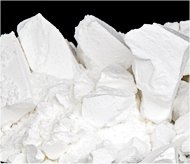
July Editorial
Upsilite - an amorphous, anhydrous magnesium carbonate.

July Editorial
Upsilite - an amorphous, anhydrous magnesium carbonate.
|
The impossible has now became possible. A research group at the Nanotechnology and Functional Materials Division in Uppsala University in Sweden has managed to synthesize amorphous anhydrous magnesium carbonate, resulting in a surface area of approximately 800 m2 per 1 gram of substance. ('Amorphous' is a term used to describe a solid which does not exhibit a crystalline structure. While there may be local ordering of the atoms or molecules in an amorphous solid, no long-term ordering is present.) While this may not sound like a major development, the long term implications are significant. Also, working out how to do the synthesis was a fascinating scientific puzzle in its own right.
|
The base element required, magnesium, is the eighth most abundant element in the Earth's crust and it is one of the essential elements in the metabolism of most living species. In nature magnesium carbonates exist as traces in most geological structures. Interestingly pure magnesium carbonate is seldom found on its own in larger deposits. This is in contrast to other metal carbonates. The traces found are invariably in the form of hydrated carbonates, for example hydromagnesite (4MgCO3·Mg(OH)2·4H2O). Note the 'H2O' part - that's the water that makes up the 'hydro' part of the name. Until now it has been impossible to get magnesium carbonate in this form without water. |
|
|
Anhydrous (water-free) magnesium carbonate had been produced before in the laboratory by precipitating MgCO3 from Mg(HCO3)2 solutions. However, this was done by holding temperatures above 100 C to keep the water out. As soon as the temperature was lowered to room temperature, the magnesium carbonate hydrated. Attempts to produce anhydrous magnesium carbonate at low temperature were invariably unsuccessful. In 1908, German researchers claimed that the method for producing other disordered carbonates, i.e. by bubbling CO2 through an alcoholic suspension simply did not work with magnesium carbonate. Subsequent studies in 1926 and 1961 came to the same conclusion. The phenomenon even got a name - 'the magnesite problem' However, one day in 2011 researchers from Uppsala University got lucky. They had slightly altered the parameters of a previously used reaction, and then by mistake left the resultant material in the reaction chamber when everyone left for the weekend. When the researchers got back on Monday they discovered that the substance in the reaction chamber had set into a rigid gel. As they analysed the gel, the group got more and more excited. They had managed to create a substance which for the last 100 years was thought to be an impossible. To put it simply the scientists found that their compound formed easily at low temperature in a methanol solution of MgO with CO2. It took another year for detailed analysis, fine tuning of the reactions and other 'grunt work', but the researchers definitely had an amorphous, anhydrous magnesium carbonate which could be synthesised at room temperature in the lab. They named the substance Upsalite. Researchers find the properties of Upsalite fascinating. For a start the material has a huge surface area. As mentioned above, this synthetic magnesium carbonate has an area of 800 square meters per gram. That's the highest surface area yet found for any alkali earth metal carbonate. The synthesized material has a huge number of tiny pores (around 6 nanometers in diameter). This large number of tiny pores gives Upsalite a unique way of interacting with the surrounding environment. For example it has been shown that it can absorb more water at low relative humidities than the best material presently available (hydroscopic zeolites -microporous, aluminosilicate minerals which are widely used as commercial adsorbents.) Most of the absorbed water is retained by Upsalite even when the humidity is decreased from 95% to 5% at room temperature. The scientists hope that their new amorphous, anhydrous magnesium carbonate will find uses for humidity control, as industrial absorbents and in filters. It can also be used to control environmental moisture in the electronics and drug formulation industry or even to absorb toxic waste, chemicals and oil spills. Journal Reference:
| |
| _______________________________ | ||||
| Home | | | Shopping | | | Database |
© Biscuit Software 2004-2015
All rights reserved